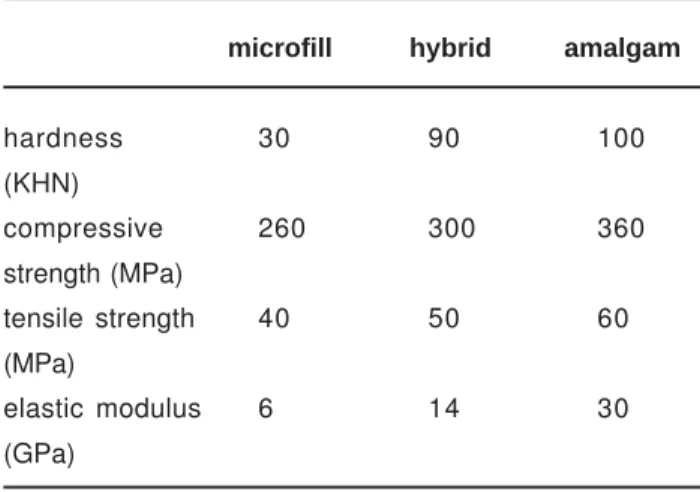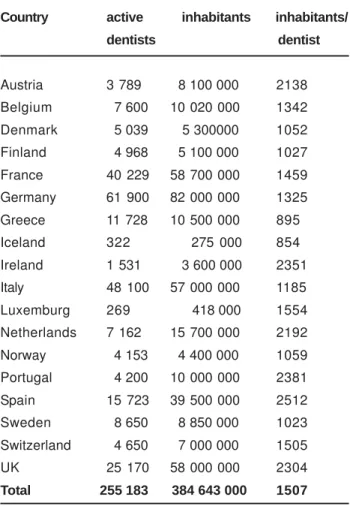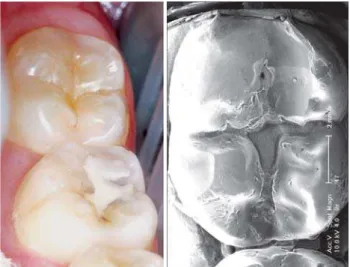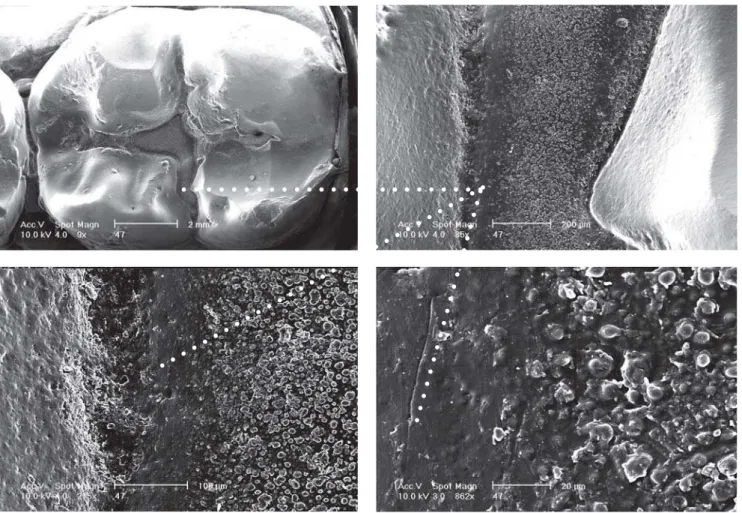T
E
ABSTRACT
RESUMO
ADVANCES IN GLASS-IONOMER CEMENTS
AVANÇOS EM CIMENTOS DE IONÔMERO DE VIDRO
Carel Leon DAVIDSON
PhD. Emeritus Professor in Dental Materials Science, University of Amsterdam, The Netherlands.
Corresponding address: Carel Leon Davidson - Department of Dental Materials Sciences - University of Amsterdan - Rubensstraat 90II,
Amsterdan, the Netherlands - Tel: + 31 (0) 20 6628162 - e-mail: c.davidson@hetnet.nl
his article describes the properties, advances and shortcomings of glass-ionomer cement as a restorative material. The adhesion of glass-ionomer to tooth structure is less technique sensitive than composite resins and its quality increases with time. Therefore glass-ionomer might turn out to the more reliable restorative material in minimal invasive dentistry based on adhesive techniques.
Uniterms: Glass ionomer cements adhesion; Minimum intervention; Sealant restorations.
ste artigo descreve as propriedades, avanços tecnológicos e limitações dos cimentos de ionômero de vidro como material restaurador. A adesão dos cimentos ionoméricos à estrutura dental é menos sensível às variações técnicas do que o mecanismo de adesão das resinas compostas e a qualidade do cimento se aprimora com o uso clínico. Portanto o cimento de ionômero de vidro torna-se o material restaurador mais confiável em procedimentos restauradores minimamente invasivos baseados em técnicas adesivas.
Unitermos: Cimentos de ionômero de vidro, adesão; Minima intervenção; Selantes.
INTRODUCTION
There is a continuous urge for novelties in dentistry originating from changing professional perceptions, changing demands from the patient and progress in industrial possibilities. The altering professional perceptions come along with raising consciousness that caries treatment is not merely technique, but requires a bio-medical approach, that less-invasive techniques are possible, that bio-compatibility requires increased interest, that there are challenging new possibilities and that there exist new markets5.
The patient has changed as they demand more esthetics, established bio-compatibility and lower costs. On top of that industry contributed substantially in progressive possibilities, such as computerized systems, CAD/CAM, optical reading and cutting, chemical reading and cutting, physico-chemical bonding and new materials.
Today’s dentistry can be characterized by a move away from metal towards non-metal restorations. Motivation is mainly based on concern for esthetics and biocompatibility.In direct restorative dentistry this means a shift from amalgam to composites. For direct restorations, three essentially different materials are at our disposal:
amalgam, resin-based composites and glass-ionomers. Of all direct dental restorations in the Netherlands10, in 1993, 30% were performed in tooth colored alternatives for amalgam; in 1997 this number was 50% and in 2002 this number was 70%! Restoring in tooth colored materials is nowadays the first option in the teaching programs at the dental schools in the Netherlands.
Amalgam
Amalgam excellently served dentistry for almost 200 years! Why changing a winning horse?
The reluctance for amalgam originates from its composition and structure. Basically amalgam is a mercury alloy and in our case a silver-mercury alloy. The reaction of only silver powder with mercury into a solid silver-mercury component proceeds too slow for restorative application, which necessitated additional more reactive metals. Often we saw and see that attempts to improve turns out to compromise other characteristics. In case of dental amalgam the increase in setting time was at the cost of strength and corrosion resistance. The chemical reaction of dental silver amalgam can roughly be described by:
The Greek letter γ (gamma) denotes the crystallographic identification of the various components. The stannous-mercury component Sn8Hg or γ 2 forms the weak link in the set composite structure. As can be seen from Table 1 the γ
2-phase is substantially weaker than the other ones, but what is worse, its corrosion potential is far negative. When two metals with unequal corrosion potential are in electrical contact within an electrolyte (water or saliva), the less noble metal will dissolve by releasing ions. It is very likely that the reactive mercury ions immediately will react with the remaining γ component in the restoration, whilst the harmless tin ions will disappear. Yet, the result of this corrosion is that the surface, and later the bulk of the restoration becomes porous, which does not contribute to the esthetics and strength of the restoration. The γ 2-phase is the Achilles heel of dental amalgam and suppression of this component could be achieved by adding small quantities of copper to the alloy. The copper-containing, so-called non-γ 2 amalgams indeed showed less corrosion. Addition of copper to silver amalgam suppresses the formation of the γ 2 – phase Sn8Hg, which improves the alloy considerably12. Whether the use of amalgam in dentistry should be limited or avoided for biological reasons is still open for discussion. In the Netherlands, the official standpoint is that there is no scientific evidence that amalgam is a serious hazard for the patient, whilst the dental team can be at risk of mercury poisoning, if no adequate hygienic measures are taken11.
Apart from the above arguments, amalgam holds another serious problem. Because of its brittleness the restoration should be as bulky as possible, and by absence of adhesion, cavity preparation is based on macro-mechanical retention. Both measures imply that placement of amalgam is usually associated with sacrifice of sound tooth structure. Today, the opinion holds that, if prevention has failed, the dentist should only minimally sacrifice sound tooth structure when restoring the tooth. Within this concept, adhesion is essential. There are at the present two classes of materials which allow direct restorations with adhesive techniques. These are resin-based composites and glass-ionomer cements.
Composites
It goes beyond the scope of this paper to cover structure and properties of resin-based composites, but some essentials will be discussed. In mechanical sense, the stronger resin-based composites can compete with dental
amalgam (Table 2).
In contrast to the superior esthetics of resin-based composites stands their great handicap, which is that their hardening is associated with polymerization shrinkage. It takes most conscientious understanding and technical skill to avoid leakage notwithstanding sophisticated bonding systems. It has to be appreciated that leakage is the most common reason for secondary caries and replacement of the restoration. Due to failing adhesion and premature fracturing and wear, the lifetime of a resin-based composite restoration is limited. The longevity of a restoration depends not only on the material, but also on the cavity size and location as well as on the dentist and the patient.
The longevity of a posterior amalgam restoration runs up to 10-14 years, whilst resin-based composites have to be replaced after 4-7 years18. This means that the longevity of a composite restoration is only half that of an amalgam restoration. In addition it takes approximately 2- 4 times more time to make a composite than an amalgam restoration. Consequently resin-based composite restorations are expensive and cost much chair time. An amalgam restoration is usually better and a composite restoration is often worse than it looks. As a matter of fact, it takes a good dentist to make a good composite and a bad one to make a bad amalgam. If a plenty skilled dentists are available, resin-based composites may contribute to very satisfying dentistry, but problems arise if there exists a shortage.
Table 3 shows the dentist density in a series of European countries. The variety in number of dentists per 1000 inhabitants is striking and might have repercussion on either the number of patients receiving dental care or on the quality of the dentistry in that particular area. This problem might be solved if the dental treatment was not becoming more and more demanding. For example any composite restoration has to be preceded by tissue conditioning and application of the bonding. Moreover this procedure has to be done in perfect humidity control and in a concept of optimal tissue micro-infiltration by resins and fighting polymerization contraction of the ultimate filling material.
There exists consensus on the fact that the “three step bonding” ends up to the best results. In practice these three
γ γ γ γ
γ γ γ γ γ γ1 γγγγγ2
hardness (KHN) 120 100 30
compressive strength (MPa) 530 - 70
tensile strength (MPa) 450 - 35
corrosion potential (mV) 180 150 -150
TABLE 1- Some characteristics of the different γ-phases in
silver-tin amalgam
microfill hybrid amalgam
hardness 30 90 100
(KHN)
compressive 260 300 360
strength (MPa)
tensile strength 40 50 60
(MPa)
elastic modulus 6 14 30
(GPa)
steps consist of many more. For proper application of the best established bonding systems one consecutively has perform the following steps: etching, rinsing, drying, mixing of primer, priming agitation, air blowing of primer, additional priming, application of adhesive, impregnation of adhesive, spreading of adhesive, light curing and additional curing. These total 7 – 12 steps takes at least 2 - 3 minutes chair time. Proper bonding requires deep knowledge and great skill; more than before, the quality of the restoration is determined by the dentist factor. The latest bonding generations became more operator friendly, but their clinical durability is reduced6. On top of this premature in situ degradation of bonding and composite limit the lifetime of these kinds of restorations21.
The conclusion so far might be that resin-based composites are highly aesthetic alternatives for amalgam that can be used with minimal invasive treatment, but that particularly the bonding procedure is too demanding for wide-scale dentistry.
Glass-ionomers
Fully in contrast with resin-based composites is application and bond formation with glass-ionomers. It is true, the bond strength reaches only 25% of that can be obtained with resin bonding systems13, but at least the bond is reliable and disintegration resistant. Glass-ionomers do not require extra provisions for consistent retention or adhesion, as they adhere directly to, even humid, dental
hard tissues15 (Figure 1). As filling material, glass-ionomer cement mimics tooth colour not as good as composites and shows faster surface loss by wear, but since its less technique demanding it may serve in many ways more successfully than resin-based composites. As the surface properties are apparently inferior to composites its significance lies mainly in the field of dentine replacement in sandwich restorations. It has to be appreciated that glass-ionomer is an inorganic material and thus predisposed to acid erosion. In Figure 2a is shown how decreasing pH affects wear significantly. This acid susceptibility is less present for the resin-modified glass-ionomers (Figure 2b), which were merely developed to obtain command set of glass-ionomers by admixing light-curing hydrophilic resins to the glass-ionomer.
Note that the vertical axis in Figure 2b is twice as high as that of Figure 2a, which implies that wear of the resin-modified types wear considerably faster than the conventional ones. In Figure 3 is shown how conventional glass-ionomers seriously can erode when used in danger areas in risk patients. Also excessive consumption of soft drinks might put conventional glass-ionomer restorations at risk (Table 4).
For direct restorative dentistry, the slow setting of conventional glass-ionomers is felt as an inconvenience. Apart from the irritant of waiting for finishing the restoration, a drawback of the slow setting is that the water content of the freshly placed cement can easily be altered either by dehydration or water uptake from the saliva. If the immature restoration is not protected by a varnish, the surface might be damaged as is shown in Fig.4a where even after some days the surface of normally set and unprotected glass-ionomer is dye infiltrated.
The loosely bound water may have a negative effect on initial solidity of glass-ionomer, but is at the same time responsible for positive characteristics such as curing shrinkage relieve and continuing chemistry throughout the bulk material, which reinforces the material and facilitates fluoride release.
A, yet not fully established technique, by which the cements hardening is substantially accelerated with ultrasonic or heat treatment may solve many problems related to the slow setting of glass-ionomers. Figure 4b shows that accelerated hardening prevents the glass-ionomer for dye penetration. Mechanical properties are also significantly enhanced by heat or ultra-sound treatment. For this reason no specific values for glass-ionomer are given in Table 2.
Country active inhabitants inhabitants/
dentists dentist
Austria 3 789 8 100 000 2138
Belgium 7 600 10 020 000 1342
Denmark 5 039 5 300000 1052
Finland 4 968 5 100 000 1027
France 40 229 58 700 000 1459
Germany 61 900 82 000 000 1325
Greece 11 728 10 500 000 895
Iceland 322 275 000 854
Ireland 1 531 3 600 000 2351
Italy 48 100 57 000 000 1185
Luxemburg 269 418 000 1554
Netherlands 7 162 15 700 000 2192
Norway 4 153 4 400 000 1059
Portugal 4 200 10 000 000 2381
Spain 15 723 39 500 000 2512
Sweden 8 650 8 850 000 1023
Switzerland 4 650 7 000 000 1505
UK 25 170 58 000 000 2304
Total 255 183 384 643 000 1507
TABLE 3- Dentist density in various European countries
water 7.0 mineral water 4.1
coffee 3.8 orange juice 3.2
beer 4.3 seven-up 3.2
yoghurt 3.8 apple juice 2.8
wine 3.4 coca cola 2.7
Sealants
Thanks to their applicability under humid conditions and direct bonding to tooth enamel, the inorganic glass-ionomers are practicable alternatives for resin fissure sealings. To some extend, the affirmed low wear resistance, which causes the sealant already to erode after some months14,16, may substantially be reduced by using heavy filled restorative glass-ionomer materials in stead of the thin fissure sealant glass-ionomer varieties. Although the glass-ionomer sealant visually disappears soon after placement, its preventive effect was reported still effective after 5 years. SEM images, obtained by replica techniques from the fissures showed clinically imperceptible, retained material (Figure 5). The presence of this material may be responsible for the prolonged prevention efficacy1,3. Literature is not conclusive on the reason why this retained material is more resistant to erosion4,17. Shimokobe20 suggested that under oral conditions, glass-ionomer sealants might gradually change into a new, more durable structure with high retention. He expected that with help of the mineralising potential of saliva, glass-ionomers might transform into an enamel-like structure called “pseudo enamel”. In addition to the satisfaction with glass-ionomer as an effective way of preventing fissure caries, van Duinen et al7 observed clinically visible changes in the glass-ionomer as shown in Figure 5 and 6. These changes referred to translucency, smoothness and hardness. In analogy to the (re-) mineralising power on tooth structures19, the potential of saliva as a reinforcing agent for restorative materials was suggested.
The ideal pit and fissure sealant should be a full proof obstruction for the damaging effects of dental plaque at sites of the tooth that hardly can be cleaned with domestic measures. A tight-adhering, erosion-resistant, impermeable layer covering the tooth fulfills that goal. If the retention and its erosion resistance are guaranteed for a substantial number of years, there is nothing against the use of the, basically inactive, resin-based materials for this purpose. However, application of resins requires extensive tooth surface conditioning, whilst the hydrophobic material is essentially unwelcome in the humid oral environment. In contrast to this, the hydrophilic glass-ionomer requires only minor substrate conditioning and shows a tight adhesion to enamel but unfortunately will erode easily.
Mejare and Mjør14 reported that teeth sealed with resins more frequently develop caries than teeth sealed with glass-ionomer. This, in spite of the fact that the bulk glass-ionomer sealant had visually vanished within a few months, while the majority of the resin sealants showed retention for 5 years and more. Their findings can be explained by either an unperceived sealant residuum or a longtime (after-) effect of the fluoride release from the meanwhile eroded glass-ionomer. Mejare and Mjør14 explained their observations by SEM-imaging, which revealed still retained “glass-ionomer” in the depth of the fissure at sites, where clinically no remnants of the cement were detectable. These remnants may be the same as the “intermediate” layer as postulated by Wilson et al.23, being the product of an exchange reaction between the poly-acid and the hydroxyl-apatite. That deeply
hided, difficultly accessible inorganic layer should possess a high acid- resistance as it constantly will be covered by dental plaque. It is reasonable to attribute this quality for a great deal to fluoride from the glass-ionomer.
Van Duinen et al7 demonstrated that glass-ionomer adjacent to tooth structure and in contact with the oral fluids, frequently altered into a material with unexpected cutting resistance and displaying raised Calcium- and Phosphate content. It was remarkable that such an altered layer was only detectable after a couple of years’ performance, whilst its thickness increased with time. This indicates that, with time, the exchange process continues and consequently the glass-ionomer restoration gains in quality, starting from the outer surface and the junction with tooth structure. It appears that, glass-ionomer performs clinically better than from laboratory research may be expected8,17. As saliva and its minerals play a crucial role in mineralization processes2, it can be understood that only under in vivo circumstances the glass-ionomer surface changed into the new structure. Okada et al16 showed that glass-ionomer stored in saliva has an improved surface hardness compared to samples stored into water. Also in deeper areas exchange processes has been reported22. Geiger and Weiner9 demonstrated between dentin and glass-ionomer an intermediate exchange layer containing fluoridated carbonate-apatite.
CONCLUSIONS
In contrast to resin bonding, the adhesion of glass-ionomer to tooth structure is not technique sensitive and its quality increases with time. Therefore glass-ionomer might turn out to the more reliable restorative material in minimal invasive dentistry based on adhesive techniques.
Glass-ionomer is not only bioactive, but has even features of an intelligent material. Glass-ionomer can be called active as it releases fluoride, it can be called intelligent, because it releases fluoride proportionally to the acidity. To some extend it has a pH buffer capacity.
A persisting concern of conventional glass-ionomers is their brittleness and low wear resistance. The latter is even pH-dependent which means that proper oral hygiene is vital. 1. For socio-economical reasons, direct restorative techniques are preferred over indirect ones.
2. Interest in amalgam is fading.
3. Resin based composites are unforgiving, over developed materials and still are far from perfect.
4. Shortcomings invariably have to be tackled by sophistication of placement techniques.
5. Glass-ionomers and their application technique is still open for improvements.
6. Glass-ionomers are forgiving, bio-active and intelligent materials.
FIGURE 1- GIC bond strength [MPa] to contaminated substrates
FIGURE 2- pH-dependent erosive wear of conventional and light-curing glass-ionomers.
(Note that the vertical axis in b is 2x that of a)
FIGURE 5- Clinical and SEM aspect of a two-year old glass-ionomer fissure sealing in a 47.
The transformation is visible at the borderline of the fissure
FIGURE 3- Poor hygiene can cause severe and progressive erosion in conventional glass-ionomer restorations. (Courtesy Dr. Raimond van Duinen)
FIGURE 4- Dye infiltration in normally (a) and ultra-sonically (b) set GIC after 3 days water storage. (Courtesy Dr. Raimond van Duinen)
a
FIGURE 6- Various SEM magnification aspects of the altered glass-ionomer sealing of Figure 5
○ ○ ○ ○
○ ○ ○ ○
○ ○ ○ ○
○ ○ ○ ○
○ ○ ○ ○
○ ○ ○ ○
○ ○ ○ ○
○ ○ ○ ○ ○ ○ ○ ○ ○ ○ ○ ○ ○ ○ ○ ○ ○ ○ ○ ○ ○ ○ ○ ○ ○ ○ ○ ○
○ ○
○ ○
○ ○
○ ○
○ ○
○ ○
○ ○
○ ○
○ ○
○ ○
REFERENCES
1- Arends J, Christoffersen J, Ruben J, Jongebloed WL. Remineralization of bovine dentin in vitro. The influence of F content in solution on mineral distribution. Caries Res. 1989;23:309-14.
2- Boksman L, Gratton DR, McCutcheon E, Plotzke OB. Clinical evaluation of glass-ionomer cement used as a fissure sealant. Quintessence Int. 1987;18:707-9.
3- Campos Serra M, Cury JA. The in vitro effect of glass-ionomer cement restorations on enamel subjected to a demineralization and remineralization model. Quintessence Int. 1992;23:143-7.
4- Davidson CL. Glass-ionomer cement, an intelligent material. Bull Group Int Rech Sci Stom Odontol 1998;40:38-41.
5- Davidson, CL. Restorative materials. In: Fejerskov O, Kidd E, editors. Dental Caries, the disease and its clinical management. Oxford: Blackwell/Munksgaard; 2003. p. 276-82.
6- De Munck J, Van Meerbeek B, Yoshida Y, Inoue S, Vargas M, Lambrechts P et al. Four-year water degradation of total etch adhesives bonded to dentin. J Dent Res. 2003;82:136-40.
7- van Duinen RNB, Davidson CL, de Gee AJ, Feilzer AJ, In situ transformation of Glass-ionomer into an Enamel-like Material. Am J Dent. 2004;17(4):223-7.
8- Ferrari M, García-Godoy F. Sealing ability of new generation adhesive-restorative materials placed on vital teeth. Am J Dent. 2002;15:117-28.
9- Geiger SB, Weiner S. Fluoridated carbonatoapatite in the intermediate layer between glass-ionomer and dentin. Dent Mater. 1993;9:33-6.
10- Health Council of the Netherlands. Committee on Dental Restorative Materials. Dental Restorative Materials. Rijswijk: Health Council of the Netherlands; 1998. /Publication no. 1998/09/
11- Marek MI. Alterations of dental amalgam. In: Eliades G (Ed). Dental materials in vivo. Chicago: Quintessence; 2003. p.61-77.
12- McCabe JF. Applied dental materials. Oxford: Blackwell Munksgaard;1996.
13- McLean JW. Dentinal bonding agents versus glass-ionomer cements. Quintessence Int. 1996;27:659-67.
14- Mejare I, Mjør IA. Glass-ionomer and resin-based fissure sealants: a clinical study. Scan J Dent Res. 1990;98:345-50.
15- Mount GJ. Glass-ionomer cements: past, present and future. Oper Dent. 1994;19:82-90.
16- Okada K, Tosaki S, Hirota K, Hume WR. Surface hardness change of restorative filling materials stored in saliva. Dent Mat. 2001;17:34-9 .
17- Smales RJ, Gao W, Ho FT. In vitro evaluation of sealing pits and fissures with newer glass-ionomers developed for the ART technique. J Clin Pediatr Dent. 1997;21(4):321-3.
19- Segura A, Donly KJ, Stratmann RG. Enamel remineralization on teeth adjacent to Class II glass ionomer restorations. Am J Dent 1997;10:247-50.
20- Shimokobe H. Properties as a pit and fissure sealant. In: Katsuyama S, Ishikawa T, Fujii B (Eds). Glass ionomer dental cement, the materials and their use. Saint Louis: Ishiyaku EuroAmerica; 1993.
21- Söderholm KJ. Degradation mechanisms of dental resin composites. In: Eliades G (Ed). Dental materials in vivo. Chicago: Quintessence; 2003. p. 99-124.
22- Ten Cate JM, van Duinen RNB. Hypermineralization of dentinal lesions adjacent to glass-ionomer cement restorations. J Dent Res. 1995;74:1266 -71.



